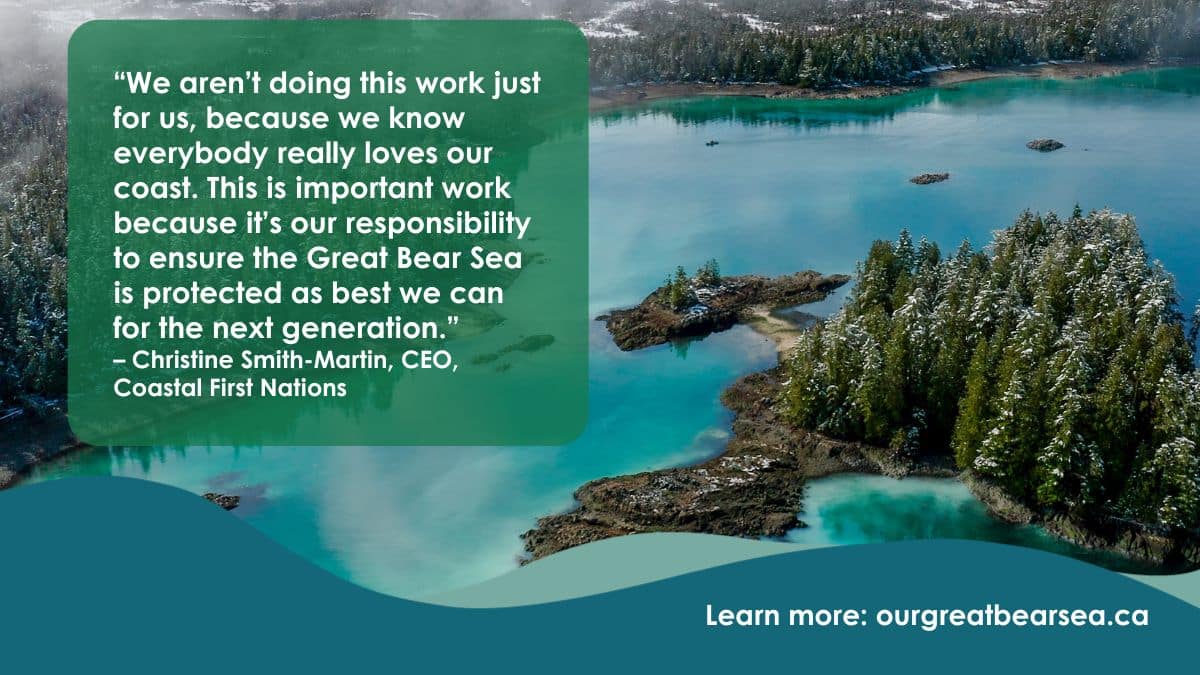Charting a new path for the Great Bear Sea How Indigenous Nations, governments, and communities are breaking the mould
July 9, 2024 – Debra Sinarta, Marine Research Coordinator, Ocean Program
Despite success stories and significant progress in marine conservation initiatives, their planning, implementation, and effective management are often hindered by a seemingly stale yet crucial element: finance.
We see the same problem in many different forms: conservation projects never get started because of a lack of necessary funds, or initiatives get underway but progress falls short when the money runs out.
To reach the United Nations Convention on Biological Diversity’s goal of protecting 30% of the ocean by 2030 globally, the estimated annual management costs range between $103 billion and $178 billion, according to a report (Waldron et al., 2020). However, global investments in protected areas hover around $24 billion per year, highlighting a significant boost in funding is needed to meet this goal.
It’s a problem that’s on the verge of being solved in parts of BC.
Over the past year, we’ve started to see announcements that will secure the long-term health of nature. In November, we saw the Nature Agreement and the BC Conservation Fund. On June 25, 2024, a similar $335 million agreement was announced for the Great Bear Sea, which covers two-thirds of the coast of British Columbia!
The Great Bear Sea is an ecological and cultural treasure that supports vast open ocean, estuaries, kelp forests, coral and sponges, and deep fjords. Unfortunately, overfishing, habitat degradation, increased shipping, and climate change are threatening the health and resilience of the Great Bear Sea and the coastal peoples that depend on it.

We need a two-pronged approach to help address these problems: creating a Marine Protected Area Network that considers the ecosystem as a whole, and securing the necessary lasting funding to bring it to life.
The Great Bear Sea Project Finance for Permanence initiative can help to advance both. Here’s how:
Long-Term and Large-Scale Impact:
The Project Finance for Permanence (PFP) is an innovative and proven conservation finance model that combines public and private investments from a diverse array of partners—including governments, NGOs, private investors, and local communities— to support permanent conservation strategies and sustainable economic development.
Often, conservation efforts rely on one-time or limited donations or grants. Although these funds are crucial for supporting individual projects, depending on incremental funding can introduce instability, lack of continuity, and gaps in protection.
Rather than seeking short-term funding to support one site, this new model aims to secure the necessary long-term financing, governance agreements, and strong conservation and development goals needed for lasting success across large-scale conservation efforts.
Collaborative Management:
The PFP approach unites governments, NGOs, donors, and local communities to fulfill a common conservation vision. It coordinates resources and efforts across these key partners to ensure that strong, sustained governance is in place for designing and implementing conservation commitments.
Following the Great Bear Sea MPA Network endorsement one year ago, collective and timely work is needed to bring the network to life. The Great Bear Sea announcement is an essential backing to advance the collaborative implementation of the Network Action Plan. This stable funding will be crucial in building capacity across partners, ensuring the continued management and monitoring of the MPAs, and fostering Indigenous-led governance in the decision-making process.
It’s anticipated it will also support the creation of more than 3,000 new jobs and 200 new businesses over the next 20 years. This is critical to ensure that those living near these vulnerable habitats can thrive where they live and help ensure local support. These opportunities will span diverse sectors, including marine stewardship, renewable energy, sustainable fisheries, and eco-cultural tourism. This will not only bolster local communities but also contribute to a sustainable and prosperous future for the region.
Holistic and Shared Vision:
The Great Bear Sea Initiative and MPA Network are the result of nearly two decades of collaborative work led by 17 First Nations, who’ve been stewarding these lands and waters for thousands of years, in partnership with the Government of Canada and the Province of British Columbia. And the vision is clear: Indigenous-led governance and stewardship, supported by stable, self-determined finance, to ensure the well-being of people and ecosystems across the Great Bear Sea for future generations.
The Great Bear Sea PFP is transforming how we finance and manage conservation, ensuring ecological, social, political, and financial sustainability. This is an exciting milestone for the lasting protection of the Great Bear Sea and a historic step forward for Indigenous-led conservation. It’s the realization of decades of vision and collaboration across the region. As we look to the future, this initiative showcases the power of collaboration and innovative finance in securing a thriving Great Bear Sea for generations to come.


